
Indoor air quality (IAQ) is the air quality within buildings and structures. Poor indoor air quality due to indoor air pollution is known to affect the health, comfort, and well-being of building occupants. It has also been linked to sick building syndrome, respiratory issues, reduced productivity, and impaired learning in schools. Common pollutants of indoor air include: secondhand tobacco smoke, air pollutants from indoor combustion, radon, molds and other allergens, carbon monoxide, volatile organic compounds, legionella and other bacteria, asbestos fibers, carbon dioxide, ozone and particulates. Source control, filtration, and the use of ventilation to dilute contaminants are the primary methods for improving indoor air quality.

Ventilation is the intentional introduction of outdoor air into a space. Ventilation is mainly used to control indoor air quality by diluting and displacing indoor pollutants; it can also be used to control indoor temperature, humidity, and air motion to benefit thermal comfort, satisfaction with other aspects of the indoor environment, or other objectives.

Passive house is a voluntary standard for energy efficiency in a building, which reduces the building's ecological footprint. Conforming to these standards results in ultra-low energy buildings that require little energy for space heating or cooling. A similar standard, MINERGIE-P, is used in Switzerland. Standards are available for residential properties and several office buildings, schools, kindergartens and a supermarket have also been constructed to the standard. The design is not an attachment or supplement to architectural design, but a design process that integrates with architectural design. Although it is generally applied to new buildings, it has also been used for refurbishments.
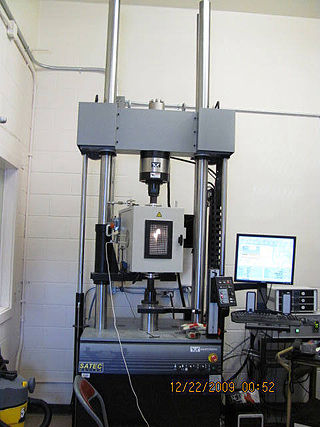
Building science is the science and technology-driven collection of knowledge in order to provide better indoor environmental quality (IEQ), energy-efficient built environments, and occupant comfort and satisfaction. Building physics, architectural science, and applied physics are terms used for the knowledge domain that overlaps with building science. In building science, the methods used in natural and hard sciences are widely applied, which may include controlled and quasi-experiments, randomized control, physical measurements, remote sensing, and simulations. On the other hand, methods from social and soft sciences, such as case study, interviews & focus group, observational method, surveys, and experience sampling, are also widely used in building science to understand occupant satisfaction, comfort, and experiences by acquiring qualitative data. One of the recent trends in building science is a combination of the two different methods. For instance, it is widely known that occupants' thermal sensation and comfort may vary depending on their sex, age, emotion, experiences, etc. even in the same indoor environment. Despite the advancement in data extraction and collection technology in building science, objective measurements alone can hardly represent occupants' state of mind such as comfort and preference. Therefore, researchers are trying to measure both physical contexts and understand human responses to figure out complex interrelationships.
Displacement ventilation (DV) is a room air distribution strategy where conditioned outdoor air is supplied at a low velocity from air supply diffusers located near floor level and extracted above the occupied zone, usually at ceiling height.
A carbon dioxide sensor or CO2 sensor is an instrument for the measurement of carbon dioxide gas. The most common principles for CO2 sensors are infrared gas sensors (NDIR) and chemical gas sensors. Measuring carbon dioxide is important in monitoring indoor air quality, the function of the lungs in the form of a capnograph device, and many industrial processes.
Thermal comfort is the condition of mind that expresses subjective satisfaction with the thermal environment. The human body can be viewed as a heat engine where food is the input energy. The human body will release excess heat into the environment, so the body can continue to operate. The heat transfer is proportional to temperature difference. In cold environments, the body loses more heat to the environment and in hot environments the body does not release enough heat. Both the hot and cold scenarios lead to discomfort. Maintaining this standard of thermal comfort for occupants of buildings or other enclosures is one of the important goals of HVAC design engineers.

Passive ventilation is the process of supplying air to and removing air from an indoor space without using mechanical systems. It refers to the flow of external air to an indoor space as a result of pressure differences arising from natural forces.
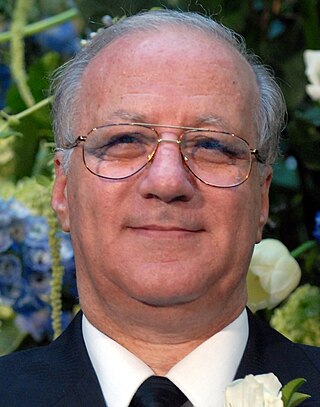
Essam Eldin Khalil Hassan Khalil is an Egyptian Mechanical Engineer. Khalil is a professor in the mechanical power department at Cairo University. He is the author and co-author of several international researches in HVAC field. He has many years of experience in delivering courses in air-conditioning to University, college students, to building managers and maintenance staff in both the industrial and commercial sectors in Egypt, the Arabian countries and worldwide. He has been selected by various universities and international organisations to lecture to graduate and post graduate level engineers, managers, supervisors and operating personnel on the subjects of HVAC design and optimisation, HVAC system management, energy utilization, waste heat recovery, plant management and other related subjects.
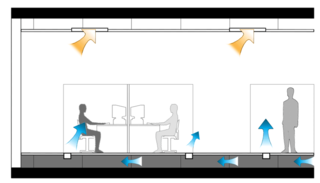
Underfloor air distribution (UFAD) is an air distribution strategy for providing ventilation and space conditioning in buildings as part of the design of a HVAC system. UFAD systems use an underfloor supply plenum located between the structural concrete slab and a raised floor system to supply conditioned air to supply outlets, located at or near floor level within the occupied space. Air returns from the room at ceiling level or the maximum allowable height above the occupied zone.

Air Infiltration and Ventilation Centre (AIVC) is the International Energy Agency information centre on energy efficient ventilation of buildings.
Building airtightness can be defined as the resistance to inward or outward air leakage through unintentional leakage points or areas in the building envelope. This air leakage is driven by differential pressures across the building envelope due to the combined effects of stack, external wind and mechanical ventilation systems.
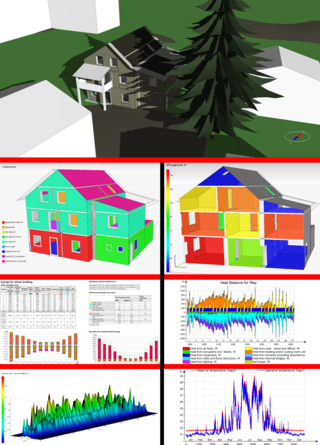
Building performance simulation (BPS) is the replication of aspects of building performance using a computer-based, mathematical model created on the basis of fundamental physical principles and sound engineering practice. The objective of building performance simulation is the quantification of aspects of building performance which are relevant to the design, construction, operation and control of buildings. Building performance simulation has various sub-domains; most prominent are thermal simulation, lighting simulation, acoustical simulation and air flow simulation. Most building performance simulation is based on the use of bespoke simulation software. Building performance simulation itself is a field within the wider realm of scientific computing.
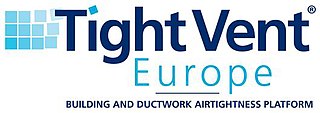
TightVent Europe is a platform focused on building and ductwork airtightness issues. The platform's creation was triggered to meet the 2020 targets of the Directive on the energy performance of buildings and overcome the challenges related to envelope and ductwork leakage towards the generalization of nearly zero-energy buildings. The platform's main activities include producing and disseminating policy-oriented publications, networking among local or national airtightness associations, and organizing conferences, workshops and webinars.

Venticool is an international platform formed in 2012 focusing on ventilative cooling issues, with the overall goal to "boost awareness, communication, networking and steering research and development efforts in the field" . In 2020, venticool's focus was broadened towards resilient ventilative cooling.
Demand controlled ventilation (DCV) is a feedback control method to maintain indoor air quality that automatically adjusts the ventilation rate provided to a space in response to changes in conditions such as occupant number or indoor pollutant concentration. The most common indoor pollutants monitored in DCV systems are carbon dioxide and humidity. This control strategy is mainly intended to reduce the energy used by heating, ventilation, and air conditioning (HVAC) systems compared to those of buildings that use open-loop controls with constant ventilation rates.
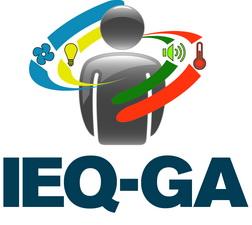
The Indoor Environmental Quality Global Alliance (IEQ-GA) was initiated in 2014 aiming to improve the actual, delivered indoor environmental quality in buildings through coordination, education, outreach and advocacy. The alliance works to supply information, guidelines and knowledge on the indoor environmental quality (IEQ) in buildings and workplaces, and to provide occupants in buildings and workplaces with an acceptable indoor environmental quality and help promote implementation in practice of knowledge from research on the field.

Ventilative cooling is the use of natural or mechanical ventilation to cool indoor spaces. The use of outside air reduces the cooling load and the energy consumption of these systems, while maintaining high quality indoor conditions; passive ventilative cooling may eliminate energy consumption. Ventilative cooling strategies are applied in a wide range of buildings and may even be critical to realize renovated or new high efficient buildings and zero-energy buildings (ZEBs). Ventilation is present in buildings mainly for air quality reasons. It can be used additionally to remove both excess heat gains, as well as increase the velocity of the air and thereby widen the thermal comfort range. Ventilative cooling is assessed by long-term evaluation indices. Ventilative cooling is dependent on the availability of appropriate external conditions and on the thermal physical characteristics of the building.
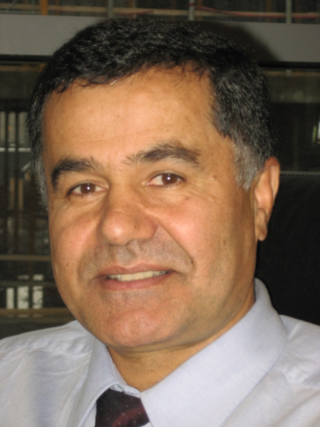
Fariborz Haghighat is an Iranian-Canadian academic, engineer and Distinguished Professor of Building, Civil & Environmental Engineering at Concordia University. Haghighat has a Concordia University Research Chair in Energy and Environment and he was Inducted into the Provost's Circle of Distinction in 2009.

Dusan Licina is an engineer and researcher specializing in indoor air quality, building ventilation, and human exposure. He is a professor at EPFL and head of the Human-Oriented Built Environment Laboratory.















